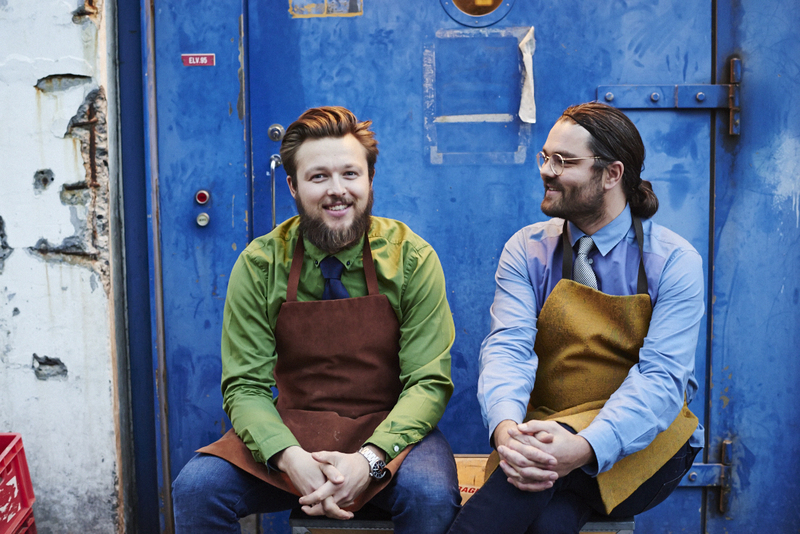Creating memorable eating experiences while jumping fences

Bo Lindegaard
This is not a scientific article. Scientific methods in cooking were an attempt to innovate within an industry that caters to basic human senses and emotions.
Neither is this yet another story about how Nordic cuisine changed the world. Because we don't believe it really did. We undoubtedly acknowledge its impact on today’s trends, but we don’t consider the Nordic cuisine to be different from other regional kitchens, such as the Italian or Chinese. It is a box, a framework, a brand that the world was eager to meet and we, the stakeholders, where happy to settle within it.
So what is this article about? It is about the combination of traditional handicraft and food design. It is about new friendships across diverse creative industries and how we together should move forward, jumping off the New Nordic wave to catch a new and bigger swell.
When thinking of what I should write in this article, I came to realize that we (as chefs) are in a sense, homeless. We innovate and believe in a better and more diverse edible future, but our end product is often misplaced. This results in chefs creating their own niches and/or restaurants, where they grow a perception of creative freedom. It is within this space, the restaurant, that I find a problem.
I would like to address this space, which I perceive as a box, and question the traditional framework of the restaurant. What is the definition of a restaurant? A bistro? A brasserie? A café?
A restaurant is by definition a place where people pay to sit and drink and eat meals that are cooked and served on the prem-ises. A brasserie is also a restaurant, but more relaxed. A bistro is yet another kind of restaurant, but smaller and less expen-sive. And a café serves lighter meals and drinks.
So basically, they are all the same. I admit that there are differences, but when it comes down to the point, the differences are costs and if there is a printed menu or white linen on the tables. They are all French terms and even though I personally enjoy going to all of these places, their nature eliminates any relevant innovation and is controlled by pre-determined spectators expectations and old fashioned rituals. It is a very hard place to change and why would you?
Instead of trying to change your girlfriend’s habits, you should find a new one!
In the following, I would like to present where we, my partner and I, are at this moment. Which platform do we seek, what do we believe is the future of Nordic Cuisine and how is it getting cooked up?
Overall, our hope for the individual niches is that they turn into communal spaces.
What is a KOMBO?
Our interpretation of the meal involving various creative industries and the focus on a more social perspective, will gradually find more and more ground in the world of haute cuisine. This vision corresponds to the overall global tendency of social awareness. At the same time, the interaction between creative industries allows gastronomy to benefit from fascinating game changing inventions. Imagine how 3D-print can change the outlook of gastronomy – the future will bring you food in different ways and not necessarily on a plate! Some people believe knowledge is becoming a commodity – a product that we can acquire instantly, while brewing a cup of coffee. Some people say creative insight and industries are the new morning. That future innovation and progress is a matter of mobile thinking and actionable performance.
We call it mobile actionability. To this we add social diversity. We believe the spirit of creative industries to be curiosity con-taining an explicit urge to cross boundaries in the quest for new social space. We believe new social space to be the platform of visionary expression. We are a social brick-building agency. By refining tastes and textures of food and inventing new frameworks for the meal we establish new social space. Instead of plastic we use food. We don’t limit ourselves by defining our field of work through nationality or culture. We expand our scope by regarding ourselves as creative agents willing to incorporate any relevant brick in the building of new social space. We conceive the meal to be applicable for social space to occur. We dissolve the traditional meal format to make this space new.
All of this sums up. We are not just a meal factory, a mobile catering company or a controversial eatery. We include the entire concept of a meal.
We wish to create a mealing manual, anticipating a new way of sharing and consuming food. It is a mealing theory defining relevant values and courses for the meal to be a common experience. It is about capturing new space. The conscious intro-duction of coincidence by interaction and a consequent exploration and use of different expressive languages is our way of establishing relevant circumstances for new social space to occur. We believe the true matter of mealing is creating an inspi-rational social space by the intervention of food.
We have introduced our key values and principle around the world at several culinary summits. Every time we have been surprised by the effect of our work. By transgressing cultural, national and technical boundaries using food as a way of com-municating, we have discovered tools with a significant impact. To make food, to eat food and to feel satisfied all take the same effort as building a friendship, a company and any communal space – a certain rhythm and interaction.
In the autumn of 2014, the Nordic Council of Ministers invited a group of leading players from across the Nordic Region to discuss their visions for the future of Nordic food. This essay formed part of this initiative #Nordicfood2024